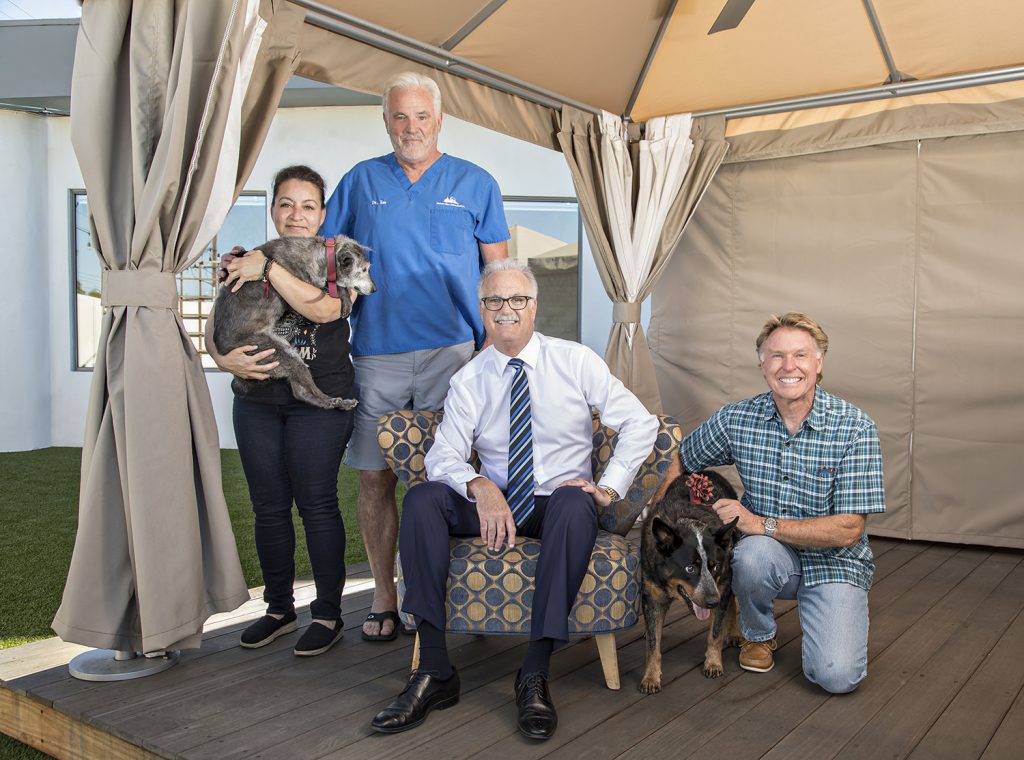
After treating more than 100 people in what appears to be a breakthrough clinical trial for management of consistent, unbearable foot and leg pain, Newport Beach podiatrist Ivar Roth’s unique treatment, called Paincur, has literally gone to the dogs.
And that’s a good thing, said Newport-Mesa Veterinarian Tom Irwin, who happens to be a Roth patient being treated for incessant degenerative/arthritic knee pain.
During one session, “Dr. Roth asked me if I would be open to new ideas for pet health and pain,” Irwin shared. In the last couple of months, “I have conducted clinical trials on 15 geriatric dogs,” all of which have been suffering severe arthritis and spinal pain issues leading to varying degrees of immobility.
“A couple of the animals responded (to the injections) within 20 to 30 minutes; the majority within 24 hours,” Irwin said. Most of the canine “patients” have been Labs, but a German Shepherd, Pit Bull and Terrier have joined the mix.
Although it’s too soon to tell long term results, “three patients have had remarkable success, four have had good response, three have had fair response, two have had minimal success (but those never completed the recommended series of five Paincur4pets injections),” Irwin reported.
According to both doctors, the injections are cumulative. For canines, an initial shot in just the right spot on the paw(s) of the affected limb is given to ascertain response, followed by five injections applied in as many weeks.
“We’re unsure of the number of shots required,” Irwin said. In his sample animals, the effects of injections have lasted anywhere from two to three days to several months. Dr. Roth said that a complete series for humans may number between five and 15 shots.
“Because pets can’t talk, some of the changes are subtle,” the vet said. His trained eye noticed a decrease in limping and more fluidity to the canines’ gates; pets were more willing to get up from a sitting or laying position; they go on more frequent walks, leading the owner opposed to trailing them; they wag their tails more, they sleep longer and don’t change positions as much. These results were often accompanied by “tears of joy” from appreciative pet owners.
Although he may not have shed tears of joy with his own Paincur experience, Irwin expressed “happiness with the results, thus far.” After his test injection, he said, there was no pain for 36 hours (it wore off in 48 hours). After five injections, he has noticed an 80 to 90 percent decrease in knee pain, although he noted that “the shots do not help with stiffness after sitting or standing for long periods.”
A practicing podiatrist for 36 years, Roth was the founding chairman and first podiatric foot and ankle surgeon to practice at Hoag Hospital. Influenced at an early age by his Uncle Harold, a podiatrist in Brooklyn, NY, Roth graduated with a BA from Cal State, Fullerton, then went on for his MPH in Public Health at University of Illinois, before earning his doctorate in podiatric medicine from Rosaland Franklin University, Chicago.
Unbeknown to most, according to Roth, “The foot’s bone structure is the most complex of all skeletal arrangements,” with highways of nerves coursing throughout the foot. When you add in weight bearing, “the foot becomes one of the most difficult parts of the body to treat effectively. The foot is so complex that there are still many issues that have not been fully identified or resolved and await further complex remedies,” he informed.
The ancient art of acupuncture often focuses on the nerves in the feet to temporarily treat pain and other discomforts throughout the entire body. Understanding those nerve pathways, coupled with his knowledge of pharma, has taken Roth in a “new direction: pain management,” which he now offers under the banner, Paincur.”
Using FDA-approved drugs injected into a targeted spot on the foot, “We can resolve back, hip, knee, ankle and arthritic pain. This procedure provides long-term to permanent pain relief,” his trials have shown, and markedly reduces or eliminates the need for any opiates. But, Roth underscores, it does not cure the cause of pain or discomfort; however, it certainly may eliminate the need for invasive surgical procedures requiring long recovery times followed by often painful physical therapy.
In what he calls his most dramatic result to date, a 21-year-old former gymnast and cheerleader bedridden for three years with undiagnosed pain and near-paralysis, coupled with unstoppable vomiting (and recommended for hospice care) visited Roth for a last-chance injection. Within several minutes of receiving the shot, she stopped heaving and reported a marked reduction in pain. The next day, she came in virtually pain free. A cheerleader’s brightness had returned to her eyes. (This writer reviewed the wrenching before and uplifting after videos of the patient. This definitely was not a miracle-pitching tent show from the early days of TV).
Pain is both a blessing and a curse – it’s a signal that there’s something terribly wrong, and it screamingly commands “Fix what’s wrong!” Lasting pain can force even the strongest amongst us into inefficiency and dependency. In fact, former world champion boxing legend Mike Tyson, a man who knows pain (how to dish it and take it) has found relief at Paincur.
In terms of injectable pain relief, Dr. Roth for humans and Dr. Irwin for pets are proving that Paincur (and Paincur4pets) is a lot more than just a hopeful shot in the dark.
For more information, visit https://www.conciergepodiatryspa.com/ and https://nmah.vet.




